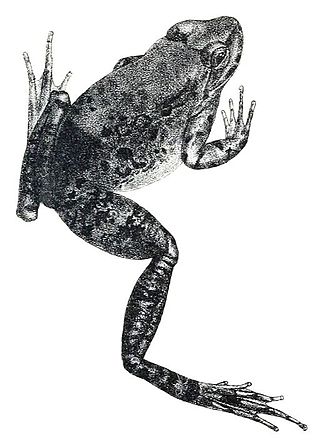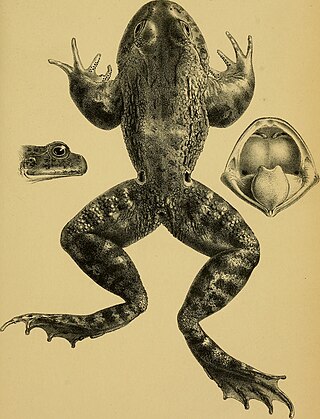
Nanorana is a genus of dicroglossid frogs. They are found in Asia, from the Himalayan region of northern Pakistan and northern India, Nepal, and western China east to montane southern China and southeast to Myanmar, Thailand, Laos, and northern Vietnam. Common names of these frogs reflect the complex taxonomic history of the genus and include Yunnan slow frogs and High Himalaya frogs.

Ombrana is a monotypic genus of frogs in the family Dicroglossidae. It is represented by a single species, Ombrana sikimensis. The validity of this genus is currently considered uncertain.

The Doichang frog is a species of frog in the family Dicroglossidae. It is only known from its type locality, Doi Chang, mountain north of Chiang Mai (Thailand), Fansipan mountain in northern Vietnam, and Huanglianshan National Nature Reserve in Yunnan, China.
Nanorana annandalii is a species of frog in the family Dicroglossidae. It is found in northeastern India and eastern Nepal. Nanorana gammii(Anderson, 1871) was until quite recently (2006) considered a synonym of Nanorana annandalii but is now treated as a separate species; this change confounds older records of Nanorana annandalii. This species lives in rocky streams and brooks in montane forests. It can also be found near pools in forest clearings. It is threatened by habitat loss (deforestation).
Nanorana arnoldi is a large species of frog in the family Dicroglossidae. It is found in southwestern China, northern Myanmar, eastern Nepal, and adjacent northeastern India. Its natural habitats are subtropical or tropical moist montane forest, rivers, and freshwater springs. It is primarily threatened by collection for consumption, but also by habitat loss.

Nanorana blanfordii is a species of frog in the family Dicroglossidae. It is found in northeastern India, southern Tibet (China), and eastern Nepal, and likely in the adjacent western Bhutan. The specific name blanfordii honours William Thomas Blandford, a British geologist and zoologist.

Nanorana conaensis is a species of frog in the family Dicroglossidae. Its name refers to its type locality, Mama in Cona County in Tibet. Note that while large parts of Cona County are located within Arunachal Pradesh in the area that is controlled by India but claimed by China, Mama is on the Tibetan side of the border. It has recently been reported also from Bhutan. Its natural habitats are subtropical moist montane forest, high-altitude shrubland, and rivers.

Nanorana ercepeae is a species of frog in the family Dicroglossidae. It is endemic to western Nepal. Its type locality is Torrent Jiuli Gad in Bajhang district. This relatively rare frog is found in stream habitats in upland temperate rainforests. One specimen of P. ercepeae was recorded from the still-water habitats of Rara Lake in Rara National Park. It is threatened by habitat loss and degradation caused by small-scale agricultural development and wood extraction.

Nanorana feae is a species of frog in the family Dicroglossidae. It is found in Yunnan, China, and the Kachin Hills in Myanmar. The specific name feae honors Leonardo Fea, an Italian explorer, zoologist, and naturalist. This little-known species probably inhabits hill streams in forested areas.

Nanorana liebigii, also known as Sikkim paa frog, Liebig's paa frog, Liebig's frog, and spiny-armed frog, is a species of frog in the family Dicroglossidae. It is found in the Himalayas, specifically in Bhutan, southern Tibet (China), northern India, and Nepal. The specific name liebigii honours a certain "Dr von Liebig Jr.", likely referring to Justus von Liebig, German botanist and chemist.
Nanorana maculosa is a species of frog in the family Dicroglossidae. It is endemic to central Yunnan, China, where it occurs in Jingdong County and Shuangbai County. This rare frog inhabits forest streams. It is threatened primarily by collection for human consumption. It is currently protected by the Ailaoshan and Wuliangshan National Nature Reserves.
Nanorana minica is a species of frog in the family Dicroglossidae. It is found in northern India and in western and eastern Nepal. It is a fairly common species found in subtropical montane forest and streams. It is threatened by habitat loss through the localized clearance of forest. Tadpoles of this N.minica has been reported to overwinter in the streams. Stream flow management and subsequent habitat modification by check dams is one of the threats the species is facing and check dams have been found to influence the overwintering tadpoles' behavior, habitat use patterns and morphometric traits.
Nanorana polunini is a species of frog in the family Dicroglossidae. It is found in Nyalam County in southern Tibet (China), Nepal, and possibly Kashmir (India). It is a common species in Nepal but rare in China. It lives in stream habitats in montane forest.

Nanorana rarica is a frog species in the family Dicroglossidae. It is endemic to western Nepal. Its type locality is the eponymous Rara Lake located in the Rara National Park.

Quasipaa spinosa is a species of frog in the family Dicroglossidae. It is known under many common names, including Chinese spiny frog, giant spiny frog, Chinese edible frog, and spiny paa frog. Its names refer to the distinctive characteristics of the species, relatively large size and the spiny chest of male frogs. Giant in frog terms only, it can nevertheless grow to lengths above 10 cm (4 in); this makes it the largest frog in Hong Kong.

Nanorana vicina is a species of frog in the family Dicroglossidae. It is found in the Himalayan front of northern India and Pakistan. Its natural habitats are high-altitude rivers, springs, and other running water in open forest and grassland habitats. There seem not to be any major threats to this species. Behavior, habitat use patterns and morphometric traits of the overwintering tadpoles of this species has been found to be influenced by check dams built in the montane streams.
Nanorana yunnanensis, commonly known as Yunnan paa frog, Yunnan spiny frog, Bourret's paa frog or Bourret's frog, is a species of frog in the family Dicroglossidae. It is found in southwestern China, Vietnam, Myanmar, northern Thailand, and likely in the intervening Laos. Its natural habitats are small and large streams in montane forests, scrub vegetation and grasslands, and it has also been found in ditches. It is threatened primarily by collection for human consumption, but also by habitat loss caused by agricultural development and infrastructure development.

Quasipaa is a genus of frogs in the family Dicroglossidae. The genus has no established common name, but many individual species are referred to as spiny frogs. They occur in East and Southeast Asia, from Thailand and Cambodia to southern and eastern China.












